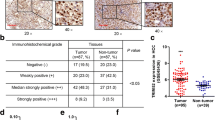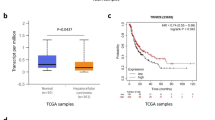Abstract
Tripartite motif (TRIM) 31 is a member of the tripartite motif-containing protein family, and TRIM family proteins are involved in a broad range of biological and pathological processes. However, the role of TRIM31 in hepatocellular carcinoma (HCC) progression is not known. Here we demonstrated that TRIM31 expression was significantly upregulated in liver cancer tissues compared with paired distal non-cancerous liver tissues from HCC patients, and its overexpression was significantly correlated with advanced disease status. Both gain and loss of function assay verified that TRIM31 promoted the malignant behaviors of HCC cells through overactivation of mammalian target of rapamycin complex1 (mTORC1) pathway. We further demonstrated that TRIM31 exerted its oncogenic effect by directly interacting with the tuberous sclerosis complex (TSC) 1 and TSC2 complex, the upstream suppressor of mTORC1 pathway, and promoting the E3 ligase-mediated K48-linked ubiquitination and degradation of this complex. In conclusion, this study demonstrated TRIM31 could promote HCC progression by targeting TSC1–TSC2 complex for degradation and further overactivating mTORC1 pathway. Thus, it revealed a novel molecular mechanism of HCC progression and indicated a potential therapeutic strategy against HCC by targeting TRIM31.








Similar content being viewed by others
References
Njei B, Rotman Y, Ditah I, Lim JK . Emerging trends in hepatocellular carcinoma incidence and mortality. Hepatology 2015; 61: 191–199.
Watanabe M, Hatakeyama S . TRIM proteins and diseases. J Biochem 2017; 16: 135–144.
Kozakova L, Vondrova L, Stejskal K, Charalabous P, Kolesar P, Lehmann AR et al. The melanoma-associated antigen 1 (MAGEA1) protein stimulates the E3 ubiquitin-ligase activity of TRIM31 within a TRIM31-MAGEA1-NSE4 complex. Cell Cycle 2015; 14: 920–930.
Song H, Liu B, Huai W, Yu Z, Wang W, Zhao J et al. The E3 ubiquitin ligase TRIM31 attenuates NLRP3 inflammasome activation by promoting proteasomal degradation of NLRP3. Nat Commun 2016; 7: 13727.
Sugiura T . The cellular level of TRIM31, an RBCC protein overexpressed in gastric cancer, is regulated by multiple mechanisms including the ubiquitin-proteasome system. Cell Biol Int 2011; 35: 657–661.
Sugiura T, Miyamoto K . Characterization of TRIM31, upregulated in gastric adenocarcinoma, as a novel RBCC protein. J Cell Biochem 2008; 105: 1081–1091.
Li H, Zhang Y, Bai X, Peng Y, He P . TRIM31 is downregulated in non-small cell lung cancer and serves as a potential tumor suppressor. Tumour Biol 2014; 35: 5747–5752.
Ra EA, Lee TA, Won Kim S, Park A, Choi HJ, Jang I et al. TRIM31 promotes Atg5/Atg7-independent autophagy in intestinal cells. Nat Commun 2016; 7: 11726.
Saxton RA, Sabatini DM . mTOR signaling in growth, metabolism, and disease. Cell 2017; 168: 960–976.
Yecies JL, Manning BD . mTOR links oncogenic signaling to tumor cell metabolism. J Mol Med (Berl) 2011; 89: 221–228.
Bhat M, Sonenberg N, Gores GJ . The mTOR pathway in hepatic malignancies. Hepatology 2013; 58: 810–818.
Dodd KM, Yang J, Shen MH, Sampson JR, Tee AR . mTORC1 drives HIF-1alpha and VEGF-A signalling via multiple mechanisms involving 4E-BP1, S6K1 and STAT3. Oncogene 2015; 34: 2239–2250.
Argyriou P, Papageorgiou SG, Panteleon V, Psyrri A, Bakou V, Pappa V et al. Hypoxia-inducible factors in mantle cell lymphoma: implication for an activated mTORC1-HIF-1alpha pathway. Ann Hematol 2011; 90: 315–322.
Kim YM, Park JM, Grunwald D, Kim DH . An expanded role for mTORC1 in autophagy. Mol Cell Oncol 2016; 3: e1010958.
Huang J, Manning BD . The TSC1-TSC2 complex: a molecular switchboard controlling cell growth. Biochem J 2008; 412: 179–190.
Herquel B, Ouararhni K, Khetchoumian K, Ignat M, Teletin M, Mark M et al. Transcription cofactors TRIM24, TRIM28, and TRIM33 associate to form regulatory complexes that suppress murine hepatocellular carcinoma. Proc Natl Acad Sci USA 2011; 108: 8212–8217.
Shen WC, Li HY, Chen GC, Chern Y, Tu PH . Mutations in the ubiquitin-binding domain of OPTN/optineurin interfere with autophagy-mediated degradation of misfolded proteins by a dominant-negative mechanism. Autophagy 2015; 11: 685–700.
Ding Q, He D, He K, Zhang Q, Tang M, Dai J et al. Downregulation of TRIM21 contributes to hepatocellular carcinoma carcinogenesis and indicates poor prognosis of cancers. Tumour Biol 2015; 36: 8761–8772.
Wang Y, He D, Yang L, Wen B, Dai J, Zhang Q et al. TRIM26 functions as a novel tumor suppressor of hepatocellular carcinoma and its downregulation contributes to worse prognosis. Biochem Biophys Res Commun 2015; 463: 458–465.
Menon S, Yecies JL, Zhang HH, Howell JJ, Nicholatos J, Harputlugil E et al. Chronic activation of mTOR complex 1 is sufficient to cause hepatocellular carcinoma in mice. Sci Signal 2012; 5: ra24.
Sun X, Han L, Seth P, Bian S, Li L, Csizmadia E et al. Disordered purinergic signaling and abnormal cellular metabolism are associated with development of liver cancer in Cd39/ENTPD1 null mice. Hepatology 2013; 57: 205–216.
El-Naggar AM, Veinotte CJ, Cheng H, Grunewald TG, Negri GL, Somasekharan SP et al. Translational activation of HIF1alpha by YB-1 promotes sarcoma metastasis. Cancer Cell 2015; 27: 682–697.
Zhao X, Gao S, Ren H, Sun W, Zhang H, Sun J et al. Hypoxia-inducible factor-1 promotes pancreatic ductal adenocarcinoma invasion and metastasis by activating transcription of the actin-bundling protein fascin. Cancer Res 2014; 74: 2455–2464.
Zhang L, Ye SB, Li ZL, Ma G, Chen SP, He J et al. Increased HIF-1alpha expression in tumor cells and lymphocytes of tumor microenvironments predicts unfavorable survival in esophageal squamous cell carcinoma patients. Int J Clin Exp Pathol 2014; 7: 3887–3897.
Villanueva A, Chiang DY, Newell P, Peix J, Thung S, Alsinet C et al. Pivotal role of mTOR signaling in hepatocellular carcinoma. Gastroenterology 2008; 135: 1972–1983.
Yamada D, Hoshii T, Tanaka S, Hegazy AM, Kobayashi M, Tadokoro Y et al. Loss of Tsc1 accelerates malignant gliomagenesis when combined with oncogenic signals. J Biochem 2014; 155: 227–233.
Kang YJ, Lu MK, Guan KL . The TSC1 and TSC2 tumor suppressors are required for proper ER stress response and protect cells from ER stress-induced apoptosis. Cell Death Differ 2011; 18: 133–144.
Huynh H, Hao HX, Chan SL, Chen D, Ong R, Soo KC et al. Loss of tuberous sclerosis complex 2 (TSC2) is frequent in hepatocellular carcinoma and Predicts response to mTORC1 inhibitor everolimus. Mol Cancer Ther 2015; 14: 1224–1235.
Newton K, Matsumoto ML, Wertz IE, Kirkpatrick DS, Lill JR, Tan J et al. Ubiquitin chain editing revealed by polyubiquitin linkage-specific antibodies. Cell 2008; 134: 668–678.
Feng M, Ding Z, Xu L, Kong L, Wang W, Jiao S et al. Structural and biochemical studies of RIG-I antiviral signaling. Protein Cell 2013; 4: 142–154.
Iwai K . Functions of linear ubiquitin chains in the NF-kappaB pathway: linear polyubiquitin in NF-kappaB signaling. Subcell Biochem 2010; 54: 100–106.
Chano T, Saji M, Inoue H, Minami K, Kobayashi T, Hino O et al. Neuromuscular abundance of RB1CC1 contributes to the non-proliferating enlarged cell phenotype through both RB1 maintenance and TSC1 degradation. Int J Mol Med 2006; 18: 425–432.
Han S, Witt RM, Santos TM, Polizzano C, Sabatini BL, Ramesh V . Pam (Protein associated with Myc) functions as an E3 ubiquitin ligase and regulates TSC/mTOR signaling. Cell Signal 2008; 20: 1084–1091.
Hu J, Zacharek S, He YJ, Lee H, Shumway S, Duronio RJ et al. WD40 protein FBW5 promotes ubiquitination of tumor suppressor TSC2 by DDB1-CUL4-ROC1 ligase. Genes Dev 2008; 22: 866–871.
Chong-Kopera H, Inoki K, Li Y, Zhu T, Garcia-Gonzalo FR, Rosa JL et al. TSC1 stabilizes TSC2 by inhibiting the interaction between TSC2 and the HERC1 ubiquitin ligase. J Biol Chem 2006; 281: 8313–8316.
Ma X, Guo P, Qiu Y, Mu K, Zhu L, Zhao W et al. Loss of AIM2 expression promotes hepatocarcinoma progression through activation of mTOR-S6K1 pathway. Oncotarget 2016; 7: 36185–36197.
Wei Q, Guo P, Mu K, Zhang Y, Zhao W, Huai W et al. Estrogen suppresses hepatocellular carcinoma cells through ERbeta-mediated upregulation of the NLRP3 inflammasome. Lab Invest 2015; 95: 804–816.
Wei Q, Mu K, Li T, Zhang Y, Yang Z, Jia X et al. Deregulation of the NLRP3 inflammasome in hepatic parenchymal cells during liver cancer progression. Lab Invest 2014; 94: 52–62.
Wei Q, Zhang Y, Sun L, Jia X, Huai W, Yu C et al. High dose of extracellular ATP switched autophagy to apoptosis in anchorage-dependent and anchorage-independent hepatoma cells. Purinergic Signal 2013; 9: 585–598.
Zhang Y, Li T, Guo P, Kang J, Wei Q, Jia X et al. MiR-424-5p reversed epithelial-mesenchymal transition of anchorage-independent HCC cells by directly targeting ICAT and suppressed HCC progression. Sci Rep 2014; 4: 6248.
Acknowledgements
We thank Dr Brendan D Manning (Harvard University) and Dr Cheryl Lyn Walker (Texas A&M University) for providing the TSC1 and TSC2 plasmids. This study was supported by the National Natural Science Foundation of China (No. 81472269 and No. 81672391) and the Science and Technology Development Project of Shandong Province (No. 2015GSF118047).
Author information
Authors and Affiliations
Corresponding author
Ethics declarations
Competing interests
The authors declare no conflict of interest.
Additional information
Supplementary Information accompanies this paper on the Oncogene website
Supplementary information
Rights and permissions
About this article
Cite this article
Guo, P., Ma, X., Zhao, W. et al. TRIM31 is upregulated in hepatocellular carcinoma and promotes disease progression by inducing ubiquitination of TSC1–TSC2 complex. Oncogene 37, 478–488 (2018). https://doi.org/10.1038/onc.2017.349
Received:
Revised:
Accepted:
Published:
Issue Date:
DOI: https://doi.org/10.1038/onc.2017.349
- Springer Nature Limited
This article is cited by
-
TRIM22 induces cellular senescence by targeting PHLPP2 in hepatocellular carcinoma
Cell Death & Disease (2024)
-
cGAS suppresses hepatocellular carcinoma independent of its cGAMP synthase activity
Cell Death & Differentiation (2024)
-
Tripartite motif 31 drives gastric cancer cell proliferation and invasion through activating the Wnt/β-catenin pathway by regulating Axin1 protein stability
Scientific Reports (2023)
-
TRIM28 promotes the escape of gastric cancer cells from immune surveillance by increasing PD-L1 abundance
Signal Transduction and Targeted Therapy (2023)
-
TRIM family contribute to tumorigenesis, cancer development, and drug resistance
Experimental Hematology & Oncology (2022)




